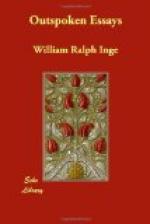[42] Dissertations, pp. 41-49.
[43] Church Congress Report, 1899, p. 63.
[44] Church Congress Report, 1899, pp. 65-67.
[45] Ibid., 1896, pp. 342-346.
[46] Epistle to the Ephesians, pp. 113, 114.
[47] Contemporary Review, April 1899.
[48] Ibid.
[49] ’Go and sit thou by his side, and depart from the way of the gods; neither let thy feet ever bear thee back to Olympus; but still be vexed for his sake and guard him, till he make thee his wife—or rather his slave.’
ROMAN CATHOLIC MODERNISM
(1909)
The Liberal movement in the Roman Church is viewed by most Protestants with much the same mixture of sympathy and misgiving with which Englishmen regard the ambition of Russian reformers to establish a constitutional government in their country. Freedom of thought and freedom of speech are almost always desirable; but how, without a violent revolution, can they be established in a State which exists only as a centralised autocracy, held together by authority and obedience? This sympathy, and these fears, are likely to be strongest in those who have studied the history of Western Catholicism with most intelligence. From the Edict of Milan to the Encyclical of Pius X, the evolution which ended in papal absolutism has proceeded in accordance with what looks like an inner necessity of growth and decay. The task of predicting the policy of the Vatican is surely not so difficult as M. Renan suggested, when he remarked to a friend of the present writer, ’The Church is a woman; it is impossible to say what she will do next.’ For where is the evidence of caprice in the history of the Roman Church? If any State has been guided by a fixed policy, which has imposed itself inexorably on its successive rulers, in spite of the utmost divergences in their personal characters and aims, that State is the Papacy.
Beneath all the eddies which have broken the surface, the great stream has flowed on, and has flowed in one direction. The same logic of events which transformed the constitutional principate of Augustus into the sultanate of Diocletian and Valentinian, has brought about a parallel development in the Church which inherited the traditions, the policy, and the territorial sphere of the dead Empire. The second World-State which had its seat on the Seven Hills has followed closely in the footsteps of the first. It is not too fanciful to trace, as Harnack has done, the resemblance in detail—Peter and Paul in the place of Romulus and Remus; the bishops and arch-bishops instead of the proconsuls; the troops of priests and monks as the legionaries; while the Jesuits are the Imperial bodyguard, the protectors and sometimes the masters of the sovereign. One might carry the parallel further by comparing the schism between the Eastern and Western Churches, and the later defection of northern Europe, with the disruption of the Roman Empire in the fourth century; and in the sphere of thought, by comparing the scholastic philosophy and casuistry with the Summa of Roman law in the Digest.[50]




